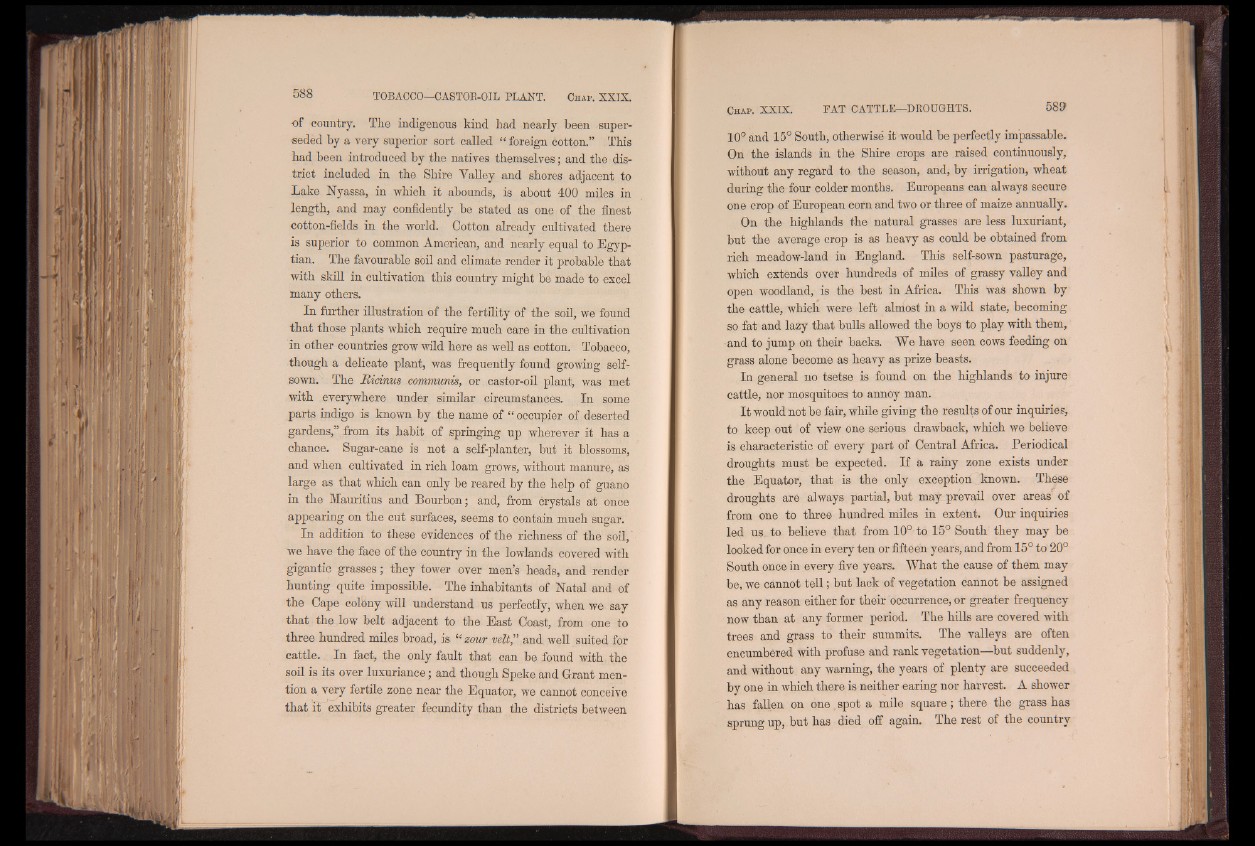
-of country. Tlie indigenous kind had nearly been superseded
by a very superior sort called “ foreign cotton.” This
had been introduced by the natives themselves; and the district
included in the Shire Yalley and shores adjacent to
Lake Nyassa, in which it abounds, is about 400 miles in
length, and may confidently be stated as one of the finest
cotton-fields in the world. Cotton already cultivated there
is superior to common American, and nearly equal to Egyptian.
The favourable soil and climate render it probable that
with skill in cultivation this country might be made to excel
many others.
In further illustration of the fertility of the soil, we found
that those plants which require much care in the cultivation
in other countries grow wild here as well as cotton. Tobacco,
though a delicate plant, was frequently found growing self-
sown. The liidnus communis, or castor-oil plant, was met
with everywhere under similar circumstances. In some
parts indigo is known by the name of “ occupier of deserted
gardens,” from its habit of springing up wherever it has a
chance. Sugar-cane is not a self-planter, but it blossoms,
and when cultivated in rich loam grows, without manure, as
large as that which can only be reared by the help of guano
in the Mauritius and Bourbon; and, from crystals at once
appearing on the cut surfaces, seems to contain much sugar.
In addition to these evidences of the richness of the soil,
we have the face of the country in the lowlands covered with
gigantic grasses; they tower over men’s heads, and render
hunting quite impossible. The inhabitants of Natal and of
the Cape colony will understand us perfectly, when we say
that the low belt adjacent to the East Coast, from one to
three hundred miles broad, is “ sour velt,” and well suited for
cattle. In fact, the only fault that can be found with the
soil is its over luxuriance; and though Speke and Grant mention
a very fertile zone near the Equator, we cannot conceive
that it exhibits greater fecundity than the districts between
10° and 15° South, otherwise it would be perfectly impassable.
On the islands in the Shire crops are raised continuously,
without any regard to the season, and, by irrigation, wheat
during the four colder months. Europeans can always secure
one crop of European corn and two or three of maize annually.
On the highlands the natural grasses are less luxuriant,
but the average crop is as heavy as could be obtained from
rich meadow-land in England. This self-sown pasturage,
which extends over hundreds of miles of grassy valley and
open woodland, is the best in Africa. This was shown by
the cattle, which were left almost in a wild state, becoming
so fat and lazy that bulls allowed the boys to play with them,
■and to jump on their backs. We have seen cows feeding on
grass alone become as heavy as prize beasts.
In general no tsetse is found on the highlands to injure
cattle, nor mosquitoes to annoy man.
I t would not be fair, while giving the results of our inquiries,
to keep out of view one serious drawback, which we believe
is characteristic of every part of Central Africa. Periodical
droughts must be expected. If a rainy zone exists under
the Equator, that is the only exception known. These
droughts are always partial, but may prevail over areas of
from one to three hundred miles in extent. Our inquiries
led us. to believe that from 10° to 15° South they may be
looked for once in every ten or fifteen years, and from 15° to 20°
South once in every five years. What the cause of them may
be, we cannot te ll; but lack of vegetation cannot be assigned
as any reason either for their occurrence, or greater frequency
now than at any former period. The hills are covered with
trees and grass to their summits. The valleys are often
encumbered with profuse and rank vegetation—but suddenly,
and without any warning, the years of plenty are succeeded
by one in which there is neither earing nor harvest. A shower
has fallen on one spot a mile square; there the grass has
sprung up, but has died off again. The rest of the country